by
G. Klust
Institut für Fangtechnik, Bundesforsohungsanstalt für Fischerei
Hamburg, Federal Republic of Germany
Stownets are long, cone-shaped netbags with a large net opening. The typical shape of a stownet is demonstrated by Figure 8c. Only the net entrance is fixed by a special device, the netbag must be kept opened by relatively strong water current. Stownets, therefore, are gears of the running water of rivers and of coastal regions with tidal water. According to the device by which the entrance of the net is kept opened, three main types may be distinguished:
All three main types are still used in German rivers, though it should be mentioned that their quantity decreases from year to year. As an example, mention should be made of the situation in the biggest German river, the river Rhine. Here, several hundreds of large stownets connected to anchored vessels (see Figures 5 and 8) were operated before the Second World War. Until 1961 the number had diminished to about 90 gears, and in 1969 only 32 stownets were still fishing in a length of about 700 km of the Rhine. Similar observations could be made in all big German rivers. There is no room left for such gears in the rivers of highly industrialised countries. In order to display their great efficiency in catching migrating silver eels, the stownets should be set in the midst of the current.
As already mentioned in the paper of v. Brandt, canalization, barrages, weirs, increasing shipping traffic and pollution of water frequently make the use of these gears impossible. The Rhine, for instance, does not only belong to the rivers with the highest density of shipping traffic in the world, but is also one of the most polluted rivers in Europe.
In the following, brief descriptions of the various types of eel-stownets are given. In addition, some details may be taken from the tables and figures.
These gears are usually set in rows, side by side, between stakes driven into the bottom. The stakes are made of wood (see Fig. 1) or are strong iron tubes (see Fig. 2). The rectangular net entrance is surrounded with a frame rope which, at the four corners, is connected to the stakes by rope loops or metal rings.
Dimensions of stownets on stakes:
| River | Ems, estuary | Middle Weser |
| Net opening | 6.30 m × 3.30 m | 4.50 m × 3 m |
| Length of the net | about 20 m | 18 m |
| Stretched mesh at the entrance | 80 mm | 80 mm |
| Last part of the net | codend with 1 funnel | fyke net with 2 funnels |
Various types of stownets at anchor are used in German rivers.
These gears have a closed, four-sided frame, mostly made of wood. Four steel-wire ropes go from the corners of the frame to an anchor which is anchored in the bottom of the river. In former times this kind of gear was operated in many German rivers also with deeper water and hard bottom, where stownets on stakes could not be set. Inasmuch as this type is stationary and immovable in the same way as stownets on stakes, it has disappeared from big rivers.
Many vessels used for this purpose do not possess an engine (e.g. in the rivers Rhine, Moselle, Maine). They have only the function to hold the catching gear, to serve as a platform for the work of the fisherman and sometimes as his lodging during night catching. Such vessels are illustrated in Figures 3 (Moselle) and 5 (Rhine). As an example the anchoring system of a vessel (called SCHOKKER) in the Rhine and the connexion between vessel and gear is shown by the three drawings of Figure 8. By lengthening or shortening the two ropes connecting the vessel with the bank and the gear, it can be shifted to a limited extent. All vessels fishing in the estuary of the big rivers are provided with engines by which they are enabled to change the catching place. These vessels have a length of 12 to 18 m with 60 to 120 hp.
In former times the entrance of the nets at anchor with vessel were mounted on a closed four-sided frame as indicated by the small drawings of Figure 6. Nowadays, however, most fishermen have replaced this frame by two beams, as shown by Figure 7, and as it is usual for a long time in the Rhine fishery (see Figs. 5 and 8). The wooden lower beam is loaded by chains. Vessels fishing in the estuary ever have two gears, fitted to either side of the vessel (Fig. 6).
Several fishermen in the Moselle and the Middle Weser do not use one gear on each side, but two smaller gears on each side of the vessel (Figs. 3 and 4).
A special, unique arrangement of stownets in the river Moselle is shown by Figure 9.
Figure 12 will give an idea of this most modern and most effective gear for catching eels in rivers. It consists of a large bagnet of about 32 m in length with a net opening of 16 m × 3 m, two wings, each of a length of 20 to 25 m, and a floating otter board. This gear was developed by the river-fisherman Koethke, 30 years ago.
The construction of the otter board may be seen from Figure 13, further details are mentioned in Table IV.
Advantages of the otter board stownet in comparison with the other types of stownets:
The large net opening and the wings give a much higher catching efficiency. The river can be shut off at a width of about 50 m.
No vessel is required if it is possible to anchor the two main ropes (Fig. 12) on one side of the bank.
The gear can easily be operated from the bank by only one man. By moving the rudder of the otter board by means of a rudder-line (“c” Fig. 12) the gear can be brought in a short time either into the free water in catching position or to the bank. In this way the gear is no hindrance for the shipping traffic. There are no ropes in front of the net opening, which possibly could scare away the fishes.
During the whole fishing period - from April to November - it is not necessary to take the gear (which is made of synthetic netting yarns) out of the water. If it does not fish it is lying in inoperative position near the bank under water.
Nowadays most of the stownets are made of polyamide filament netting yarns. The netbags are knitted from 3 or 4 sizes of netting yarn. Examples are given in Tables II and III. Experiments carried out by the author have shown that netting yarns made of polyethylene monofilaments are still more suitable for stownets, especially in very polluted waters. This floating and waxy material does not pick up so much dirt, and it is easier to clean the nets. Examples for the fineness of the netting yarns used for otter board stownets are given in Table IV.
Ten years ago all types of stownets have been knitted by hand in the form of rings with a great number of gradations in mesh size and fineness of netting yarn. (See the various mesh sizes of the stownet in Table II).
Nowadays most fishermen are making their nets from machine-made netting of different mesh size. The nettings are mostly out into rectangular strips and sewn together. The manufacturing of the nets from trapezoidly-out panels, as shown in Figures 10 and 11, is of recent date and was introduced by the Institute.
Table I
Stownet at anchor with frame - Type River Moselle
In running water, used in conjunction with vessels without motor. Special type with 5–6 units (see Fig. 9) (Generally the vessels on the river Moselle have only two units).
Netting
Net material: Usually the nets are made of PA netting yarns (staple fibres or continuous filaments) and are knitted by hand. Here, the most modern gear is described, made of polypropylene split fibres and out from machine-made netting.
| Panel | Rtex | Wet knot break load Kp | Opening of mesh mm | Number of meshes | Cutting rate | ||
| upper edge | lower edge | depth | |||||
| 1 | 2 | 3 | 4 | 5 | 6 | 7 | 8 |
| A | 1 110 | 50.8 | 140 | 450 | 450 | 5 | - |
| B | 1 110 | 50.8 | 140 | 4×112 | 4×72 | 31 | 1N4B |
| C | 785 | 41.6 | 110 | 300 | 300 | 10 | - |
| D | 785 | 41.6 | 110 | 4×75 | 4×51 | 40 | 5×1N1B+2N1B |
| E | 383 | 23.4 | 70 | 210 | 210 | 15 | - |
| F | 383 | 23.4 | 70 | 4×52 | 4×30 | 55 | 2N1B |
| G | 196 | 11.6 | 24 | 276 | 276 | 100 | - |
| H | 196 | 11.6 | 24 | 182 | 182 | 100 | - |
In G and in H a valve | |||||||
a: Frame rope, length 6 m × 2.80 m, diameter 15 mm, made of polypropylene monofilament.
Table II
Stownet at anchor with frame - Type River Rhine
In running water, used in conjunction with vessels without motor. Only 1 unit per vessel (see Figs. 5 and 8).
Netting
Net material: Braided or twisted netting yarns made of PA continuous filaments.
| Panel | Rtex | Wet knot breaking load kp | Opening of meshes mm | Number of meshes | ||||
| circumference | depth | |||||||
| 1 | 2 | 3 | 4 | 5 | 6 | |||
| A, | 1 | * | 2 800 | 160 | 240 | 640 | 4 | |
| 2 | 2 800 | 160 | 232 | 620 | 4 | ½ | ||
| B, | 3 | 2 000 | 110 | 226 | 600 | 4 | ½ | |
| 4 | 2 000 | 110 | 220 | 580 | 5 | |||
| 5 | 2 000 | 110 | 212 | 560 | 5 | |||
| 6 | 2 000 | 110 | 206 | 540 | 5 | |||
| 7 | 2 000 | 110 | 200 | 520 | 5 | ½ | ||
| C, | 8 | 1 600 | 90 | 192 | 500 | 5 | ½ | |
| 9 | 1 600 | 90 | 186 | 480 | 5 | ½ | ||
| 10 | 1 600 | 90 | 180 | 460 | 6 | |||
| 11 | 1 600 | 90 | 172 | 440 | 6 | |||
| 12 | 1 600 | 90 | 166 | 420 | 6 | ½ | ||
| 13 | 1 600 | 90 | 160 | 400 | 6 | ½ | ||
| D, | 14 | 1 250 | 65 | 152 | 380 | 7 | ||
| 15 | 1 250 | 65 | 146 | 360 | 7 | |||
| 16 | 1 250 | 65 | 140 | 340 | 7 | ½ | ||
| 17 | 1 250 | 65 | 132 | 320 | 8 | |||
| 18 | 1 250 | 65 | 126 | 300 | 8 | |||
| 19 | 1 250 | 65 | 120 | 280 | 9 | |||
| 20 | 1 250 | 65 | 112 | 260 | 9 | ½ | ||
| 21 | 1 250 | 65 | 106 | 240 | 10 | |||
| E, | 22 | 800 | 45 | 100 | 220 | 11 | ||
| 23 | 800 | 45 | 92 | 200 | 11 | ½ | ||
| 24 | 800 | 45 | 86 | 180 | 12 | ½ | ||
| 25 | 800 | 45 | 80 | 160 | 14 | |||
| 26 | 800 | 45 | 72 | 140 | 15 | |||
| 27 | 800 | 45 | 66 | 120 | 17 | |||
| 28 | 800 | 45 | 60 | 100 | 18 | |||
| 29 | 800 | 45 | 56 | 80 | 19 | |||
F: terminal fyke net
| total length in the hoops | : | 4.5 m, two funnels, |
| opening of meshes at the beginning | : | 32 mm |
| opening of meshes at the end | : | 24 mm |
| height (diameter) of the 3 circular hoops | : | 500 mm |
| Ropes | ||||
| Item | Material | Diameter mm | Breaking load Kp | Length m |
| a | steel wire | 18 | 14 000 | 10–15 (2x) |
| b | steel wire | 14 | 8 000 | 15 (4x) |
| c | steel wire | 12 | 6 000 | |
| d | steel wire | 16 | 12 000 | |
| e | steel + manila combin. | 14 | 3 000 | 30 |
Accessories
| Two beams, | wood, round, diameter 200–240 mm, length 11–12 m, under-beam loaded by thick chains. | |
| Four winches: | 1 | anchor winch (motorised), |
| 1 | winch for the lower beam of the gear (motorised), | |
| 2 | winches (by hand) for the upper beam. | |
(Owing to the variations in conditions at the different fishing places in the river Rhine - rapidity of current, depth of water - there is no uniformity in the construction of the stownets. The gear described above is used at a fishing place with a strong current.)
Table III
Stownet at anchor with frame - Type River El be (Estuary)
In running water, used in conjunction with vessels of 15–16 m LOA, 60–120 horse power - Crew - 2 men. 2 units per vessel (see Figs. 6 and 7).
Netting
Net material: Twisted netting yarns made of PA continuous filament.
| Panel | Rtex | Wet knot break load Kp | Opening of mesh mm | Number of meshes | Cutting rate | ||
| upper edge | lower edge | Depth | |||||
| 1 | 2 | 3 | 4 | 5 | 6 | 7 | 8 |
| A | 1 100 | 56 | 80 | 750 | 750 | 12 | - |
| B | 1 100 | 56 | 80 | 700 | 700 | 12 | - |
| C | 1 100 | 56 | 80 | 650 | 650 | 12 | - |
| D | 720 | 44 | 60 | 6x133 | 6x93 | 83 | 2N1B+1N1B |
| E | 550 | 36 | 40 | 6x136 | 6x90 | 150 | 3N1B |
| F | 400 | 26 | 24 | 6x150 | 6x39 | 333 | 3N1B |
| G | 320 | 22 | 24 | 200 | 200 | 125 | - |
| H | 320 | 22 | 20 | 220 | 220 | 200 | - |
| valve G | 20 | 22 | 24 | 200 | 2x20 | 62 | 1N4B |
| valve H | 320 | 22 | 20 | 220 | 2x20 | 90 | 1N2B |
Hanging ratio at the net opening  In each corner 2 × 25 meshes connected to 2 × 15 cm line. In each corner 2 × 25 meshes connected to 2 × 15 cm line. | |||||||
| Ropes |
| Item | Material | Construction | Diam. mm | Break load Kp | Length m |
| a | PP+steel combination | 6 strands. Z | 16 | 2 900 | 28–30 |
| b | Steel wire | 20 | 17 000 | 20 | |
| c | Steel wire | 14 | 8 000 | 2x50 | |
| d | Steel wire | 12 | 6 000 | 12x10 |
Accessories
I: a round (cylindr.) beam, wood, length 9 m, diameter 140 mm
II: an iron tube, round (cylindr.), length 9 m, diameter 80–90 mm
Table IV
Otter board stownet (Developed by H. Koethke)
This gear can be employed in the main stream of large rivers. It is operated from the bank of the river, without using a vessel. It consists of a large bagnet - (with a net opening of about 16 m × 3 m) - and of two wings, each of which is 20 to 25 m in length. One of the wings is attached to a large floating otter board “swimming” in the main stream, by means of which the net is kept stretched open away from the side of the channel (see Fig. 12).
Netting
Net material: Twisted netting yarns made of polyethylene monofilaments. The codend consists of netting yarns made of polyamide contin. filaments.
| Panel | Rtex | Wet knot break load kp | Opening of meshes | Number of meshes | ||
| Upper | Lower | Depth | ||||
| 1 | 2 | 3 | 4 | 5 | 6 | 7 |
| A (wing) | 1 437 | 76 | 140 | 200 | 200 | 3 m |
| B | 1 437 | 76 | 140 | 1 000 | 1 000 | 8 meshes |
| C | 1 437 | 76 | 140 | 1 000 | 800 | 72 meshes |
| D | 1 096 | 48 | 110 | 800 | 800 | 8 meshes |
| E | 1 096 | 48 | 110 | 800 | 600 | 72 meshes |
| F | 709 | 37 | 70 | 600 | 600 | 10 meshes |
| G | 709 | 37 | 70 | 600 | 200 | 140 meshes |
| H(codend) PA | 320 | 22 | 24 | 400 | 400 | 600 meshes |
Hanging ratio of panel A (wings) 
Hanging ratio of panel B (net opening): 
Colour of PE netting: green (coloured during fibre manufacturing process); without preservation.
Ropes
a: anchor ropes made of steel wire; diameter 14 to 18 mm, breaking load 8 000 to 14 000 kp;
b: frame rope made of polypropylene film or of polypropylene monofilaments; diameter 16 mm, breaking load 3 000 kp
c: rudder-line made of steel wire with a diameter of 4 mm or made of polypropylene monofilament with a diameter of 8 mm
Otter board
| (For details see Fig. 13) | ||
| Material | : | wood and iron |
| Shape | : | rectangular |
| Length | : | about 4 m with rudder |
| Height | : | 2.50 to 3.00 m |
| Float of the otter board: | ||
| Material: | galvanised iron plate, 2 mm thick, diameter of the cylindrical float: 0.30 m length: about 3.50 m | |
Danleno
| to be fitted between net opening and wings and at the end of the wing going to the bank. | ||
| Material | : galvanised iron plate, 2 mm thick | |
| Shape | : cylindrical, the ends are closed | |
| Diameter | : 70 to 100 mm | |
| Length | : about 3 m | |
| Buoys projecting out of the water to be fitted as shown in Figure 12. | ||
McGrath asked for definition of stownet.
v. Brandt- Stownet is an English word, equivalent to the German ‘Hamen’. The essentials of the stownet appear to be that the mouth is held open by rigid frame or by floats and weights and that the net itself is supported mainly by the current. The limiting factors where stownets are used include the strength of the current, the nature of the holding ground for anchorage and the burden of leaves and other material in the river.
O'Leary asked if there were any figures available for the efficiency of a stownet in relation to the cross sectional area of the mouth. He would also like to have available some figures for the drag of net expressed in kg/m2. He also would like to know the minimum economic catch per annum, which would justify the cost of installing a large stownet.
V. Brandt said that current meters have been used to try to measure forces involved but results had been contradictory. The changes in material used in net making also made reliable assessment difficult. It was not clear whether two small nets in an opening or one big one would give the better result. Materials such as polyethylene and polypropylene are good for case of cleaning. Stiff material is preferred since soft materials tend to be too flexible. No general information was available on the size of the minimum catch which would justify the use of a particular kind of net. The minimum economic catch per annum should be 1 000 to 1 500 kg under German conditions.
Moriarty asked why the nets were hung close to the surface.
v. Brandt - Surface is chosen by experienced fishermen who have found that the greatest number of eels are found there. According to tests made in the river Elbe the silver eel does not migrate near the bottom of the river channel. The otter-beard stownet can be used at any point on a river but traditionally good places are used. A licence duty is payable.
McGrath asked if there was any problem in removing trash from stownets moored to ships.
V. Brandt stated that the fishermen do not usually live on the boats, but would usually visit the nets during the night.
Vickers - was there any advantage to be gained in hanging the stownet between two boats?
V. Brandt saw no objection to using two boats, but thought it would be a rather expensive method which would not normally be justified. The size of the net is limited by boat traffic. Better to fish without a vessel and to use an otter board instead.
McGrath asked for information on the factors which determined the net length in proportion to width.
v. Brandt - length depends largely on angle of cutting of the mesh.
O'Leary asked if V. Brandt would state the best angle with the river section for the mouth of a stownet.
v. Brandt said this figure seemed to vary from site to site and there was no defined angle.
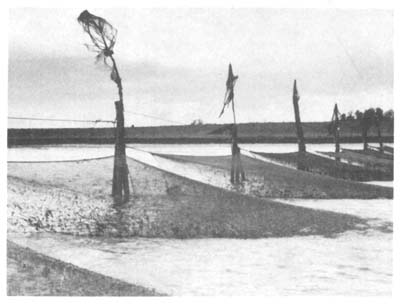
Fig. 1 Stownets at stakes in the estuary of the River Ems (from G. Klust)

Fig. 2 Stownets at stakes in the River Middle-Weser (from G. Klust)
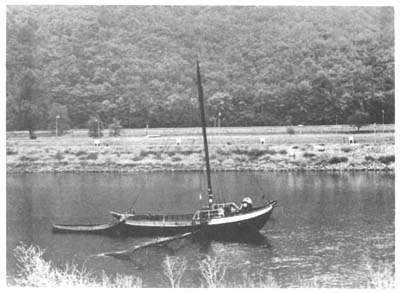 | Fig. 3 | Vessel without engine with stownets at another with two beams in the River Moselle - two small nets at one side of the vessel (from G. Klust) |
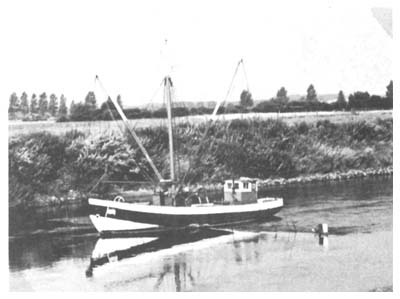 | Fig. 4 | Vessel with engine with stownets at anchor with two beams in the River Weser - two small nets at each side of the vessel (from G. Klust) |
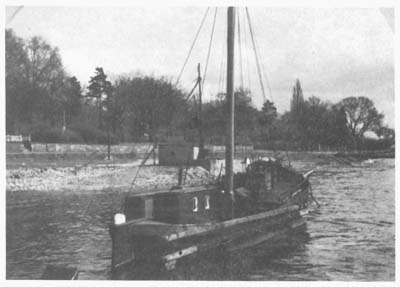 | Fig. 5 | Vessel without engine with the two beams of the stownet in the River Rhine - here only one big stownet at one side of the vessel is used (from G. Klust) |
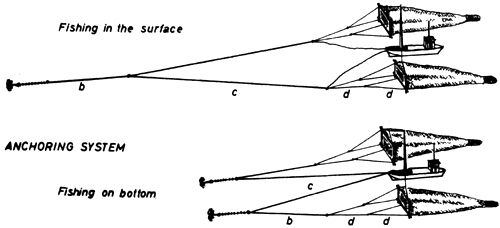
Fig. 6 Stownets at anchor in the estuary of the River Elbe. Vessel with engine; one stownet at each side of the vessel. Eelfishing: fishing in the surface. (from Klust-Kaulin)

Fig. 7 Stownet at anchor in the estuary of the River Elbe (see Fig. 6 and Table III). Connection between the frame-lines of the net-opening and the two beams (modern type). (from Klust-Kaulin)
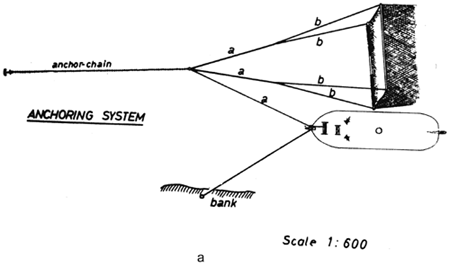
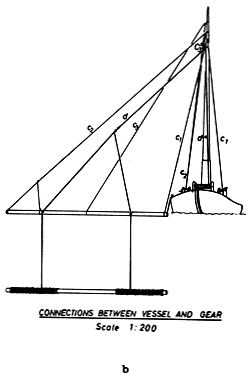
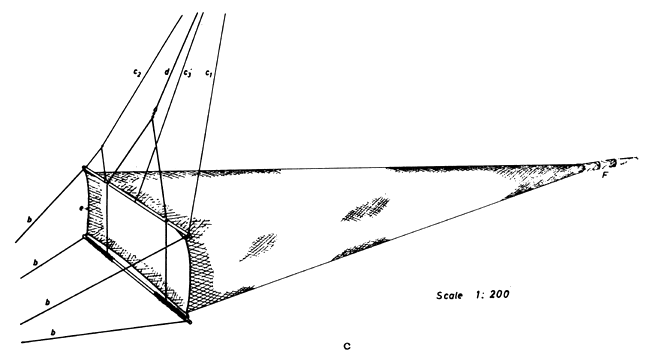
Fig. 8 Stownet at anchor - River Rhine type (see Table II). (Klust-Kaulin)
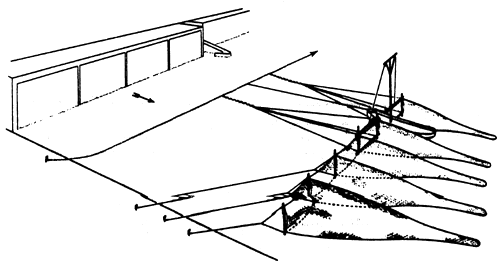
Fig. 9 Stownets at anchor in the River Moselle; 5–6 gears in a row behind a barrage. (Klust-Kaulin)
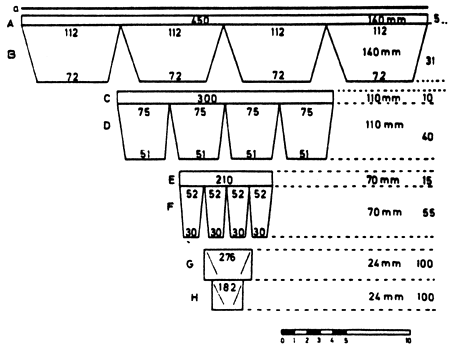
Fig. 10 Panels of one of the stownets (River Moselle, Fig. 9) (Klust)
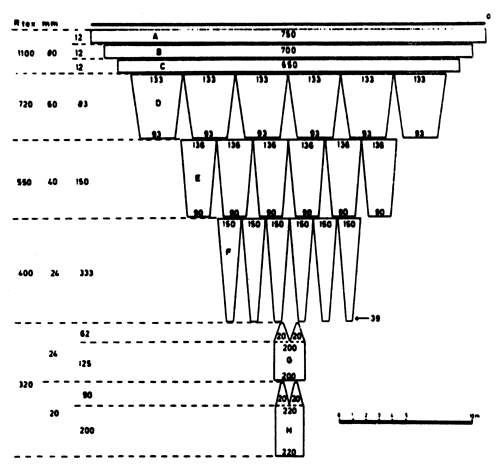
Fig. 11 Panels of the stownet at anchor, type estuary of the River Elbe. (described in Table III, see Figs. 6–7). (Klust-Kaulin)
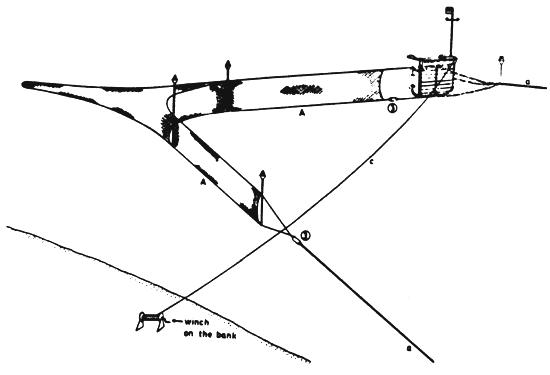
Fig. 12 Otter board stownet (Koethke) operated from the bank of rivers without vessel (schematised) (see Table IV).
| - | A | : | wings, each of which with a length of 20 to 25 m. |
| - | a | : | steel wire ropes by which the two wings are anchored on the same side of the bank. |
| - | c | : | rudder wire by which the rudder of the floating otter board (see Fig. 13) is connected to the winch on the bank. |
| (3) | : | Buoys, to prevent shafing of the wire ropes on the bottom. | |
| (Klust-Kaulin) |
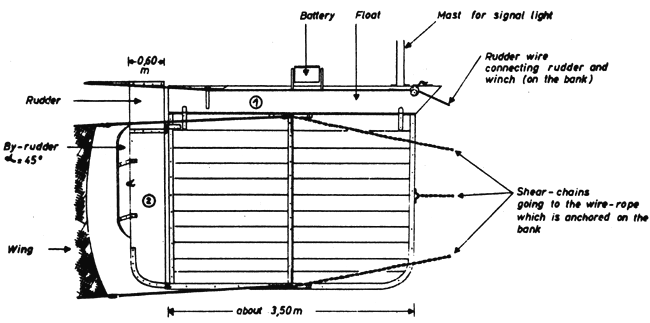
Fig. 13 Floating otter board of the otter board stownet (see Fig. 12).
- A : Cylindrical float made of thin galvanised iron plates.
- 2 : Rudder with by-rudder. (Klust-Kaulin)
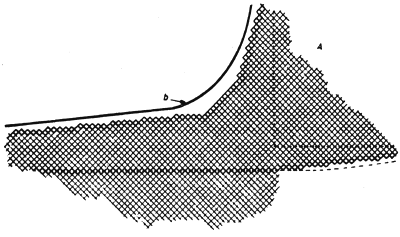
Fig. 14 Cutting of the netting in the corner between wings and net opening (Otter board stownet, Fig. 12).
| - A | : | wing. |
| - b | : | frame-rope, made of polypropylene monofilaments or combination rope made of steel wires and polypropylene monofilaments (Klust). |